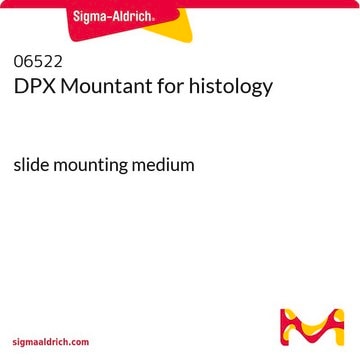Recommended Products
application(s)
hematology
histology
storage temp.
room temp
General description
Designed for orientation of excised surgical specimens. This method of permanently marking the margins of tissue specimens is very beneficial to surgeon and pathologists testing for skin cancer. This method of marking multiple margins of specimens was originally documented by Dr. Frederick Mohs. Five 2 oz. bottles of dye: blue, black, yellow, red and green. Convenient holder and application sticks.
Kit Components Only
Product No.
Description
- Red Dye (R3780) 2 oz
- Green Dye (G4421) 2 oz
- Blue Dye (B8186) 2 oz
- Yellow Dye (Y0146) 2 oz
- Black Dye (B8311) 2 oz
Signal Word
Danger
Hazard Statements
Precautionary Statements
Hazard Classifications
Aquatic Acute 1 - Aquatic Chronic 2 - Eye Dam. 1 - Skin Irrit. 2
Storage Class Code
10 - Combustible liquids
Flash Point(F)
Not applicable
Flash Point(C)
Not applicable
Certificates of Analysis (COA)
Search for Certificates of Analysis (COA) by entering the products Lot/Batch Number. Lot and Batch Numbers can be found on a product’s label following the words ‘Lot’ or ‘Batch’.
Already Own This Product?
Find documentation for the products that you have recently purchased in the Document Library.
Hong Bae Kim et al.
Technology in cancer research & treatment, 19, 1533033820948051-1533033820948051 (2020-09-29)
Tissue electrolysis is an alternative modality that uses a low intensity direct electric current passing through at least 2 electrodes within the tissue and resulting electrochemical products including chlorine and hydrogen. These products induce changes in pH around electrodes and
Hong Bae Kim et al.
Technology in cancer research & treatment, 19, 1533033820948051-1533033820948051 (2020-09-29)
Tissue electrolysis is an alternative modality that uses a low intensity direct electric current passing through at least 2 electrodes within the tissue and resulting electrochemical products including chlorine and hydrogen. These products induce changes in pH around electrodes and
Jing Chang et al.
Technology in cancer research & treatment, 19, 1533033820957022-1533033820957022 (2020-09-12)
Doxorubicin (DOX) has antitumor effects mediated by cell viability inhibition and by inducing cellular apoptosis. However, it has limited use in clinical applications due to various factors such as hydrophobicity, dose-dependent toxicity effects on normal tissues, short cycle retention time
Our team of scientists has experience in all areas of research including Life Science, Material Science, Chemical Synthesis, Chromatography, Analytical and many others.
Contact Technical Service









